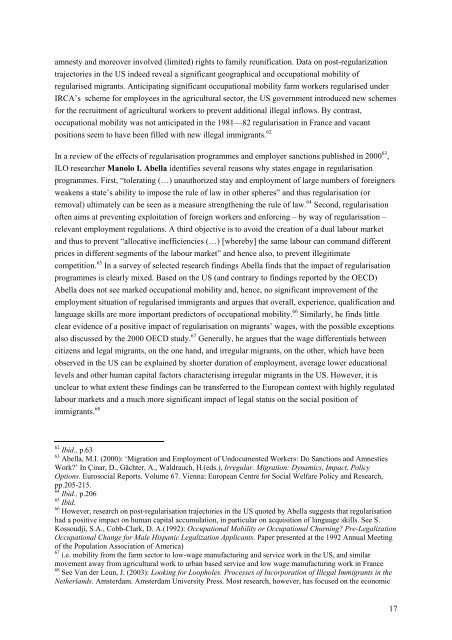REGINE Regularisations in Europe Final Report - European ...
REGINE Regularisations in Europe Final Report - European ...
REGINE Regularisations in Europe Final Report - European ...
You also want an ePaper? Increase the reach of your titles
YUMPU automatically turns print PDFs into web optimized ePapers that Google loves.
amnesty and moreover <strong>in</strong>volved (limited) rights to family reunification. Data on post-regularization<br />
trajectories <strong>in</strong> the US <strong>in</strong>deed reveal a significant geographical and occupational mobility of<br />
regularised migrants. Anticipat<strong>in</strong>g significant occupational mobility farm workers regularised under<br />
IRCA’s scheme for employees <strong>in</strong> the agricultural sector, the US government <strong>in</strong>troduced new schemes<br />
for the recruitment of agricultural workers to prevent additional illegal <strong>in</strong>flows. By contrast,<br />
occupational mobility was not anticipated <strong>in</strong> the 1981—82 regularisation <strong>in</strong> France and vacant<br />
positions seem to have been filled with new illegal immigrants. 62<br />
In a review of the effects of regularisation programmes and employer sanctions published <strong>in</strong> 2000 63 ,<br />
ILO researcher Manolo I. Abella identifies several reasons why states engage <strong>in</strong> regularisation<br />
programmes. First, “tolerat<strong>in</strong>g (…) unauthorized stay and employment of large numbers of foreigners<br />
weakens a state’s ability to impose the rule of law <strong>in</strong> other spheres” and thus regularisation (or<br />
removal) ultimately can be seen as a measure strengthen<strong>in</strong>g the rule of law. 64 Second, regularisation<br />
often aims at prevent<strong>in</strong>g exploitation of foreign workers and enforc<strong>in</strong>g – by way of regularisation –<br />
relevant employment regulations. A third objective is to avoid the creation of a dual labour market<br />
and thus to prevent “allocative <strong>in</strong>efficiencies (…) [whereby] the same labour can command different<br />
prices <strong>in</strong> different segments of the labour market” and hence also, to prevent illegitimate<br />
competition. 65 In a survey of selected research f<strong>in</strong>d<strong>in</strong>gs Abella f<strong>in</strong>ds that the impact of regularisation<br />
programmes is clearly mixed. Based on the US (and contrary to f<strong>in</strong>d<strong>in</strong>gs reported by the OECD)<br />
Abella does not see marked occupational mobility and, hence, no significant improvement of the<br />
employment situation of regularised immigrants and argues that overall, experience, qualification and<br />
language skills are more important predictors of occupational mobility. 66 Similarly, he f<strong>in</strong>ds little<br />
clear evidence of a positive impact of regularisation on migrants’ wages, with the possible exceptions<br />
also discussed by the 2000 OECD study. 67 Generally, he argues that the wage differentials between<br />
citizens and legal migrants, on the one hand, and irregular migrants, on the other, which have been<br />
observed <strong>in</strong> the US can be expla<strong>in</strong>ed by shorter duration of employment, average lower educational<br />
levels and other human capital factors characteris<strong>in</strong>g irregular migrants <strong>in</strong> the US. However, it is<br />
unclear to what extent these f<strong>in</strong>d<strong>in</strong>gs can be transferred to the <strong>Europe</strong>an context with highly regulated<br />
labour markets and a much more significant impact of legal status on the social position of<br />
immigrants. 68<br />
62 Ibid., p.63<br />
63 Abella, M.I. (2000): ‘Migration and Employment of Undocumented Workers: Do Sanctions and Amnesties<br />
Work?’ In Ç<strong>in</strong>ar, D., Gächter, A., Waldrauch, H.(eds.), Irregular. Migration: Dynamics, Impact, Policy<br />
Options. Eurosocial <strong>Report</strong>s. Volume 67. Vienna: <strong>Europe</strong>an Centre for Social Welfare Policy and Research,<br />
pp.205-215.<br />
64 Ibid., p.206<br />
65 Ibid.<br />
66 However, research on post-regularisation trajectories <strong>in</strong> the US quoted by Abella suggests that regularisation<br />
had a positive impact on human capital accumulation, <strong>in</strong> particular on acquisition of language skills. See S.<br />
Kossoudji, S.A., Cobb-Clark, D. A.(1992): Occupational Mobility or Occupational Churn<strong>in</strong>g? Pre-Legalization<br />
Occupational Change for Male Hispanic Legalization Applicants. Paper presented at the 1992 Annual Meet<strong>in</strong>g<br />
of the Population Association of America)<br />
67 i.e. mobility from the farm sector to low-wage manufactur<strong>in</strong>g and service work <strong>in</strong> the US, and similar<br />
movement away from agricultural work to urban based service and low wage manufactur<strong>in</strong>g work <strong>in</strong> France<br />
68 See Van der Leun, J. (2003): Look<strong>in</strong>g for Loopholes. Processes of Incorporation of Illegal Immigrants <strong>in</strong> the<br />
Netherlands. Amsterdam. Amsterdam University Press. Most research, however, has focused on the economic<br />
17
















